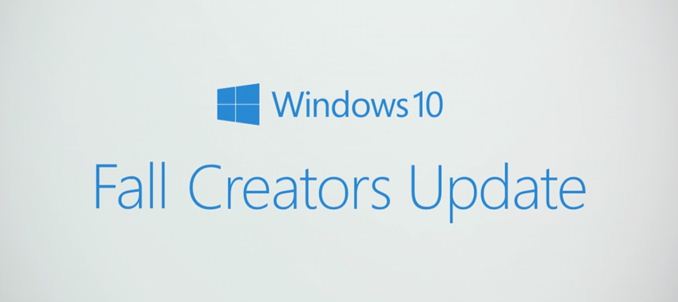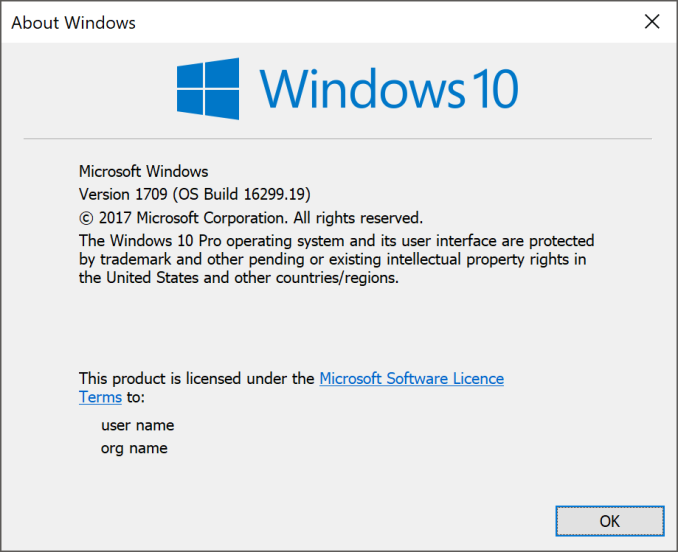The Windows 10 Fall Creators Update Feature Focus
by Brett Howse on November 10, 2017 8:00 AM EST
Windows 10 has finally settled into a groove. We are just over two years from the initial release of Windows 10. Part of the promise of Windows 10 was Windows as a service, or in other words, continual updates to Windows rather than monolithic version releases every couple of years. However, the haphazard schedule of feature updates was not pleasing to one stable customer of Microsoft’s. Businesses don’t love surprises, and they need time to plan ahead, and test, in order to deliver the vision that Microsoft has envisioned for Windows 10 going forward, so 2017 is the first year we get to see the new spring and fall updates, first with the Creators Update on April 11, 2017, and now the Fall Creators Update which became widely available on October 17, 2017.
The biannual release schedule still might be too aggressive for a lot of enterprises, but it’s a balancing act for Microsoft to keep the features coming for consumers, security updates coming for enterprise, and of course, keeping Windows 10 fresh in the eyes of everyone. Hopefully this new schedule works out though, since it’s nice to see fewer, smaller updates, rather than annual massive updates which may cause even more challenges.
| Windows 10 Version History | |||||
| Version | Version Number | Release Date | |||
| Windows 10 Original Release | 1507 | July 29, 2015 | |||
| November Update | 1511 | November 10, 2015 | |||
| Anniversary Update | 1607 | August 2, 2016 | |||
| Creators Update | 1703 | April 5, 2017 | |||
| Fall Creators Update | 1709 | October 17, 2017 | |||
And a smaller update is arguably what we’ve had for both of the 2017 releases for Windows, and that’s certainly not a bad thing. That’s not to take away from the many small changes and fixes under the hood, but more a fact that Windows 10 is solid, and stable, and updates only need to further smooth out some of the rough spots, and add a few new ideas for people to utilize. Windows 10 is now well known, with an official monthly active user base of over 500 million devices. It’s a solid number, despite being well under initial targets at launch.
With the Fall Creators Update, Microsoft has added quite a few new features, including some that missed out on the April update. They’ve taken the first step towards an improved OS and app design language since Windows 10 first launched, they’ve added more accessibility, more security, and finally added one of the top feature requests since Windows 10 launched. Let’s dig into the changes.












95 Comments
View All Comments
prophet001 - Monday, November 13, 2017 - link
*emddrіver - Monday, November 13, 2017 - link
Facebook, Google, or Amazon also do it but lets be real, how can they monetize on my data? Will a company just suddenly guess what I like and dislike on FB? Do I find search results "adjusted" to my preference? Does Amazon give me different prices and offers than others? Idiocy!Plus, there's no sensitive data about me on my phone but I have all kinds of stuff in my computer like scans of important documents, CVs, etc. No way I let M$ have that.
Screw you - Wednesday, November 15, 2017 - link
As if the average customer will actually ever check certificate information. Most don't even know what a certificate is...And your request concerning firewall protection would be for a very small minority of paranoid techno-geeks who represent an insignificant and small portion of the Windows using population... Enacting a default firewall rule to block everything would make the Windows experience cumbersome and inefficient for MOST users. Things work just fine as they are right now... You really need to get over yourself Mr. Fort Knox.edzieba - Friday, November 10, 2017 - link
It's not going to make it 'less safe' either. Two and a half years after release, and not a single shred of evidence has been uncovered of Microsoft sending your files to themselves. And you can bet security researchers have been looking very closely too.shaikhsimraan - Sunday, November 12, 2017 - link
FRP Bypass APK: https://www.yourtechnocrat.com/frp-bypass-apk/Mo3tasm - Friday, November 10, 2017 - link
Fall creator update is certainly the best Win10 update, features are reasonably polished and the build is just a lot more stable...That being said, Win10 itself is bad.. slower than Win7 or even Win8.1 (and an order of magnitude than any Linux distro), you're forced to use the system in a way that you don't necessarily like, and updates are just shoved up the ass...
ddriver - Friday, November 10, 2017 - link
Yeah, good old w7 is still the best, as long as you keep close attention to what updates you are installing.Unfortunately, m$ took measures against the selective installation of updates, and recently releases those "update bundles", each of which contains all the updates and you definitely don't want on your machine, such as telemetry.
Additionally, m$ colluded with hardware vendors to omit support for w7 from their latest hardware driver packages. Granted, some might actually work, but it is usually hacky and not 100% operational.
Really revolting, heinous, despicable behavior. Grade A scumbags...
Ratman6161 - Friday, November 10, 2017 - link
Here is the other side of the coin. The vast majority of exploits which make it into the news are exploiting know things that only work on systems that have not installed updates. Wannacry was a perfect example.Bullwinkle-J-Moose - Saturday, December 23, 2017 - link
Bad example Ratman!Wannacry had no effect on Windows XP-SP2 with no Microsoft Updates, only SP3 was affected
Once Microsoft updates yer box, NSA exploits work again like magic
Mo3tasm - Friday, November 10, 2017 - link
I suspect it also has to do with frequent updates, developers can get lazy all they want when they must fix bugs or optimize performance, because they can always do it "next month"..Back in the days when you could push major code changes only once per version they had to work really hard to perfect every line of code.